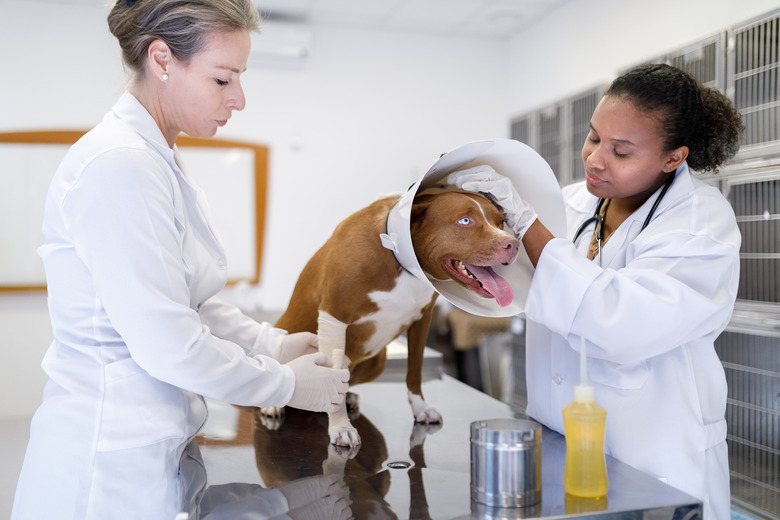Side Effects Of Buprenex In A Canine
If your dog requires pain medication, your veterinarian might prescribe buprenorphine, marketed under the brand name Buprenex. While Buprenex is only approved for human use by the U.S. Food and Drug Administration, veterinarians are allowed to prescribe the drug for extralabel use under the FDA's Animal Medicinal Drug Use Clarification Act of 1994. Most dogs tolerate the drug quite well, but side effects can occur.
Buprenex for dogs
Buprenex for dogs
Buprenorphine is an opioid drug that can be used to relieve mild to moderate pain. It is not appropriate for severe pain. In humans, addiction to opioid pain relievers is an urgent public health concern, but in dogs, this has not been observed. Your dog may receive one or more injections of buprenorphine for painful procedures or surgeries, and your veterinarian may dispense buprenorphine to be administered at home if needed. Buprenorphine is most commonly dispensed as a liquid to be given on the gums of your dogs. It absorbs through the mucosa, or lining, of the gums and cheeks. It may need to be administered every six to 12 hours.
Use of buprenex for dogs
Use of buprenex for dogs
Buprenex is often used as a post-surgery painkiller to control moderate surgical pain. If your dog has suffered trauma — although not head trauma, as the drug is contraindicated for that — broken bones, joint injuries or inflammation from disease or necrosis, your veterinarian might choose Buprenex to offer relief.
Buprenorphine side effects in dogs
Buprenorphine side effects in dogs
Buprenorphine side effects in dogs are relatively rare and mild. It does not tend to suppress respiration and heart rate like morphine and other opioid drugs. While overdose is rare, it can happen so be sure to follow your veterinarian's instructions carefully about dose and frequency. Be sure to monitor your dog after their first dose of a new medication. If your dog experiences side effects or has an allergic reaction, you'll want to be there to witness it.
Sedation is the most common side effect of buprenorphine in dogs, which is not cause for concern unless the dog is so sedated they can't be roused. If the dog received an injection of buprenorphine into a muscle, they may have some pain at the injection site. Rare side effects include agitation, increased or decreased heart rate, low body temperature, high blood pressure, and vomiting. If after buprenorphine, your dog is acting weird, contact your veterinarian to see if you should discontinue the medication or if your dog needs to be seen.
Some dogs may be allergic to Buprenex. If your dog has had an allergic reaction to other opioid drugs, Buprenex should not be used for them. Signs of an allergic reaction include hives or facial swelling. Call your veterinarian immediately if your dog appears to have an allergic reaction.
Buprenex for dogs precautions and contraindications
Buprenex for dogs precautions and contraindications
Buprenex should be used with caution in dogs with hypothyroidism, kidney, liver or heart disease or Addison's disease. Pregnant or lactating dogs should not receive this drug. Use with caution in dogs with respiratory disease, as Buprenex can sometimes slow breathing rates. Don't use a flea dip or flea collar containing amitraz on your pet while they take Buprenex, or for two weeks after treatment. It's possible the combination of these two drugs could cause high blood pressure or high body temperature.
You should tell your veterinarian about any other medications or supplements you give your dog before starting them on a new medication. If your dog still appears to be in pain while taking Buprenex, tell your veterinarian. Never give your dog any pain medications that you have at home or that were not prescribed for your dog. Your veterinarian may prescribe a nonsteroidal anti-inflammatory medication in addition to Buprenex to control your dog's pain.


